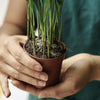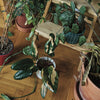7 tips on how and with what to naturally fertilize your maids

Spring is here and with it the time when it is appropriate to encourage your houseplants to grow and give them extra nutrients so that they thrive in the long term. In this article, we will introduce you to 7 tips on how to fertilize plants (and give them nutrients and vitamins) while using household waste - so read on!
At the beginning, we will not spare a few general information - specifically why, how, when and with what it is appropriate to fertilize plants.
Why fertilize?
Plants receive nutrients from the substrate, the content of which is limited by the size of the pot. However, their quantity is not inexhaustible and sooner or later the plant will use them up (therefore it is advisable to transplant the plants from time to time or to change part of the substrate). If you want to encourage plants, give them energy to grow faster and strengthen their resistance to pests, it is definitely beneficial to fertilize them.
How to fertilize?
So how can we provide plants with nutrients so that they are healthier and give us more and more joy? Above all, according to the instructions - which you can find on the purchased products. Most fertilizers are given in the form of watering, so it is also advisable to plan the fertilization in advance together with the watering, so that the plants are not unnecessarily overwatered. If you decide to fertilize at a different time, you should make sure that the substrate is not dry so that the fertilizer can be absorbed better. Pour the solution evenly over the plant and wait for the excess to drain into the saucer - remove (pour out) this excess, never let the plant stand in it!
TIP: If you are not sure about the dose of fertilizer, don't be afraid to dilute the solution more (even by half). Less is sometimes more, and this saying pays off when it comes to fertilizer!
Beware of over-fertilizing!
Everything in moderation, and the same applies to fertilization. If the plant receives an excess of nutrients, it can quickly begin to wither and die - the leaves begin to turn yellow, fall off or brown spots appear on the edges of the leaves, the white surface of the substrate can also indicate an excess of minerals. These are all symptoms of an over-fertilized maid.
when yes
The best time to give plants extra nutrients is at the beginning of the growing season (plants wake up from hibernation) - i.e. in spring. Plants are often exhausted after the winter, and with fertilizer we can give them energy to grow again and thus make us happy again.
Attention : Since spring is also the time when it is appropriate to transplant plants, check the information on the packaging of the purchased substrate - some substrates are pre-fertilized! If you are going to use such a substrate, start with the next fertilizing only after the period for which the substrate is pre-fertilized, which is usually 4-5 weeks. In this way, you prevent the possibility of harming your plants (how too much fertilization is harmful is described later in the text).
When not?
We NEVER fertilize plants if:
- They are sick or unrooted (does not apply to the use of lignohumate )
- They are freshly transplanted (let the plants rest for a while after the transplant procedure and find out information about the substrate used - if it was not pre-fertilized, etc.)
- They are in a dry substrate (it must be wetted beforehand)
- Pests are infested and we don't know what they are (there are fertilizers with an effect against pests, but in order to buy them correctly, we need to be sure what kind of pest it is)
- In winter, reduce fertilization or follow the instructions on the fertilizer package. In the case of home-made fertilizers, it is sufficient to reduce them or replace them with lignohumate.
Chemical assistants
There is a large amount of fertilizers available on the market, which you can buy almost anywhere, at our store or online shop . There are various preparations specialized for specific types of indoor plants, for example non-flowering plants, ficuses, palms, succulents, orchids and the list goes on ... For these fertilizers, carefully read the instructions for preparing the solution, because over-fertilizing could burn the plants' root system. Natural premium fertilizers include Weiki probiotics and Weiki organic fertilizer
Household leftovers
And finally, the promised tips on composting with household waste!

1. Banana, apple or onion peels
Do you have bananas or apples at home? In that case, you also have a source of natural fertilizer for maids! First of all, don't throw away the peels - we'll talk about what to do with them and how to make fertilizer from them:
- Soak the peel in water (it is convenient to use an empty canning jar in which to close the peel in water)
- Let it soak for a day or two
- We will use the leachate instead of the next dressing
- The peels can also be chopped and incorporated into the soil
Bananas contain phosphorus, calcium and potassium, which promote vitality and help increase resistance to pests and diseases. This method of fertilizing is suitable for all houseplants, but it is especially appreciated by orchids.
Similarly, you can use apple skins or onion skins - let the onion skins soak for 2 days and the resulting solution can also be used in the fight against pests, especially aphids.
TIP: If you have "aroids" houseplants (e.g. philodendrons and monsters) or succulents that prefer more acidic soil, you can prepare a dressing from orange peels for them. Pour boiling water over the orange peels, let them soak for a day or two, then water the plants. You can also leave the orange peels to dry, grind and grind them and then incorporate them into the substrate.
2. Water from potatoes, rice and lentils (unsalted!)
You can also use leachates from side dishes cooked for lunch to fertilize - but be careful, THEY MUST NOT BE SALTED! Water from boiled potatoes (preferably once a week, boiling potatoes in the skin is ideal) is most appreciated by African violets (which then bloom profusely) and the lentil water by palm trees.
TIP: Do you have an aquarium at home? If so, you can also fertilize the houseplants with water from the aquarium!

3. Coffee grounds
Do you have a coffee machine? So you also have a source of nutrients for maids. Let the coffee log dry before use (for example in newspaper) - it is then easier to handle. Gently work the dry sediment into the soil (or sprinkle it). You can repeat this once every six months.
4. Yeast
If you often bake and you have a bit of yeast left over, you can prepare a fertilizing mixture that will be especially appreciated by geraniums and orchids:
- Mix 10 g of yeast with a spoonful of sugar
- Pour in a liter of warm water
- Let it stand for two hours
- Then mix with water in a ratio of 1:5
5. Ashes from the fireplace or grill
Wood ash (briquettes or charcoal) is an alkaline fertilizer with a lot of phosphorus, magnesium, calcium and potassium, which you can sprinkle on the substrate and then gently work into the soil.

6. Eggshells
Eggshell is a rich source of calcium, which neutralizes the soil. Wash the shells from the rest of the egg and then crush them and process them into a fine powder, which you incorporate into the soil. We can also use the unsalted water that you have left over after cooking the eggs or make a decoction from the shells that we leave in the water for 2 or 3 weeks.
7. Earthworm tea
Earthworm tea is such a drink for your maids. It is a liquid fertilizer that you can make yourself at home thanks to vermicomposting. Leachate arises spontaneously from the decomposition of fruits and vegetables, peels, etc., which contains a lot of water. The container for vermicomposting contains earthworms, which feed on waste substances during the decomposition of food residues and at the same time secrete enzymes themselves, which, together with other substances in the composting process, flow into the lower container in liquid form, which we call earthworm tea. You can also get earthworm tea at home from the Urbalive vermicomposter .
We hope that after reading this article, you have a better idea of when, how and why to fertilize houseplants, and that you will find a use for some household scraps that you can now add to your plants' regular diet.
Author: B.Sc. Jana Beránková
-
Posted in
Zajímavosti a tipy




